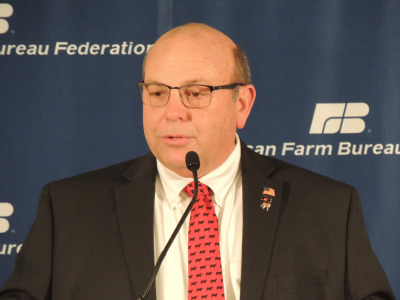A White House effort to lower the wages farms have to pay H-2A workers appears to have foundered amid concerns that it would put some regions at a disadvantage to others.
There also were concerns that an effort to cut wages looked bad at a time when workers on farms and in food processing plants were being hit by widespread outbreaks of the COVID-19 virus.
A widely circulated National Public Radio story disclosed in April that the White House chief of staff, Mark Meadows, was working with Agriculture Secretary Sonny Perdue on a plan to lower H-2A wage rates. The program’s “adverse effect wage rate,” or AEWR, which determines the minimum amount that farms are required to pay, has been rising sharply in recent years, with double-digit annual increases in some states.
But Chuck Conner, president and CEO of the National Council of Farmer Cooperatives, said the administration had been looking at tying the H-2A rates to local and state minimum wages, which could exacerbate regional disparities.
“We've been arguing for a long time that we need a change to that (AEWR) formula in order to keep wages within, you know, the same limits as what other industries were facing. With the administration’s effort we were pretty quick to also say while we appreciated the effort we did not feel like the path that they were on tying it to the minimum wage … was going to be fair,” he told Agri-Pulse.
Conner said the White House effort appeared to be dead at this point. Tying the H-2A wages to state and local minimum wage rates would have been especially unfair to California.
“This just created a lot of problems, a lot of regional problems. Obviously ,California really was adversely affected in a big way,” Conner said.

Chuck Conner, NCFC
California’s minimum wage is $13 an hour, the highest in the nation except for the District of Columbia’s $14 an hour, and is set to rise to $15 an hour by 2022. In many other states, the minimum is the same as the federal requirement, $7.25 an hour.
The White House didn’t respond to a request for comment on the proposal..
Another farm group leader, who didn’t want his name used, said the timing of the White House effort was bad, too, coming as it did as the pandemic was hitting farms.
“This approach would have been a messaging disaster and likely would result in litigation that would impede the relief anyway. If the end game were actual grower relief, there are better ways,” the official said.
The official also said if the administration really wanted to overhaul the AEWR to lower rates, it should have been included in a Labor Department proposal issued last year.
Under the department’s plan, the AEWR rate would continue to be set based on a USDA survey of farm wages, and the American Farm Bureau Federation argued that there were new provisions that would actually push the AEWR even higher in some areas for small and medium-size farms.
The H-2A rates rose 6% on average this year to $13.99, and some states saw increases of up to 10%. The AEWR for Ohio, Indiana and Illinois rose 10% to $14.52 an hour and 9% in Missouri and Iowa to $14.58 an hour.
Zippy Duvall, the president of the American Farm Bureau Federation, also said the COVID-19 crisis made it difficult to pursue reforms that would lower the AEWR rates.

Zippy Duvall, American Farm Bureau Federation
“We’re going to continue to work on that, but in this environment where everybody looks like they’re threatened on the front line and they're risking their life going to work, I mean, of course that's not a popular thing to talk about,” Duvall said of AEWR reforms.
Sara Neagu-Reed, associate director of federal policy for the California Farm Bureau, said policy makers should "focus on other priorities to help both our farmers and their employees, such as providing more funding for PPE (personal protective equipment) resources for our growers and ensuring agriculture, along with the medical sector employees, are receiving these resources ASAP. Keeping our workforce safe is our priority."
Despite farm groups’ ongoing concerns about the wage rates, they have generally praised the administration for steps taken during the coronavirus outbreak to ensure that farms could obtain H-2A workers this year.
The State Department eased interview visa requirements in Mexico after consulates were closed there in March, and the Labor Department issued a temporary rule in April to allow farms to hire H-2A workers who were already in the country, something previously prohibited.
“We have some isolated spots across the country that we've had some problems (getting workers) but overall, we've been pretty good,” said Duvall.
Interested in more coverage and insights? Receive a free month of Agri-Pulse or Agri-Pulse West by clicking here.
Nearly 90% of H-2A workers originate from Mexico, but travel issues from other key countries have presented challenges in getting workers to American operations.
One of the biggest lingering problems is with custom harvesting contractors, who normally hire about 4,000 H-2A workers from South Africa, said Michael Marsh, president and CEO of the National Council of Agricultural Employers.
Meanwhile, soaring unemployment rates in the United States have led to calls by some conservatives in Congress for shutting down guest worker programs on the basis that there are plenty of Americans to take those jobs.
Marsh’s group has started surveying state employment agencies to see whether domestic demand for agricultural positions has increased this spring. Among six or seven states that have responded so far, that hasn’t been the case, he said. Virginia, for example, reported referring just two people to farms for job openings. Idaho has reported three referrals.
“There does not seem to be a huge clamor for these unemployed domestic workers who want to come out to do the jobs on the farm,” he said.
For more news, go to www.Agri-Pulse.com.


